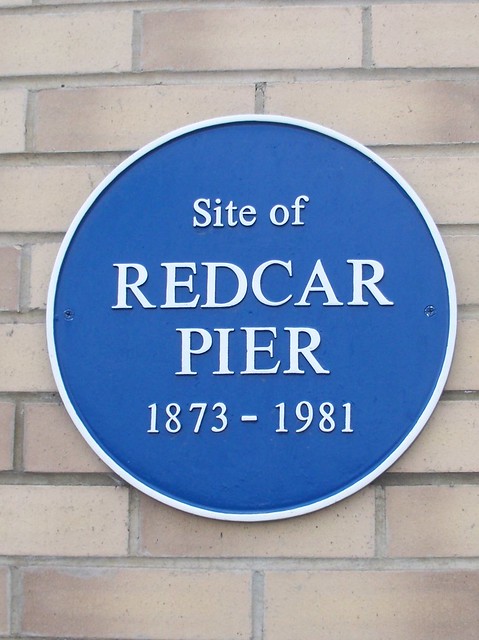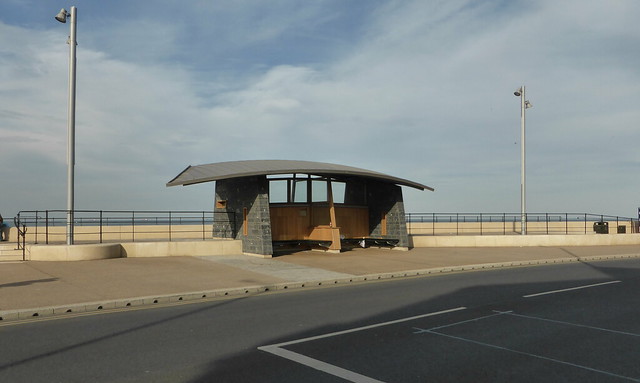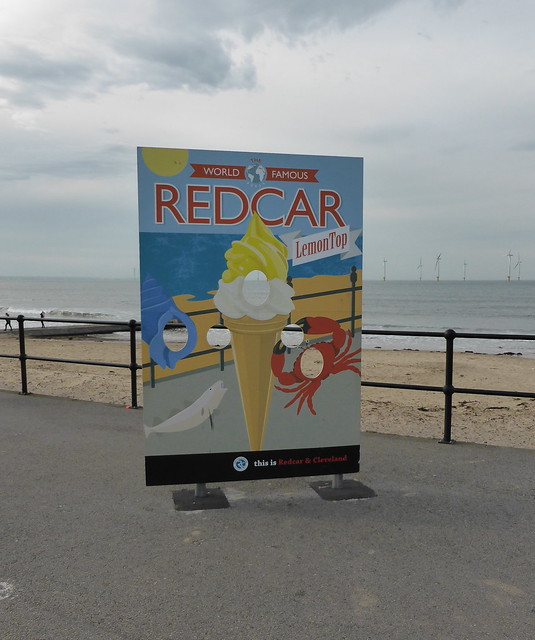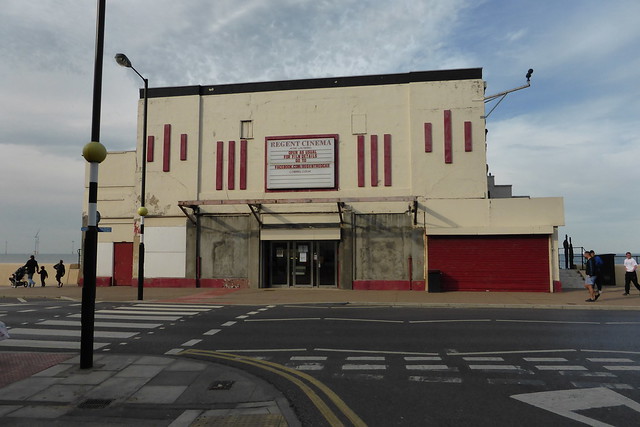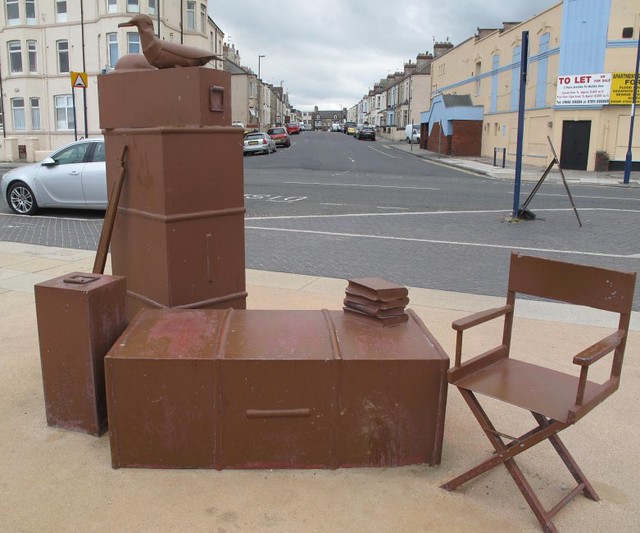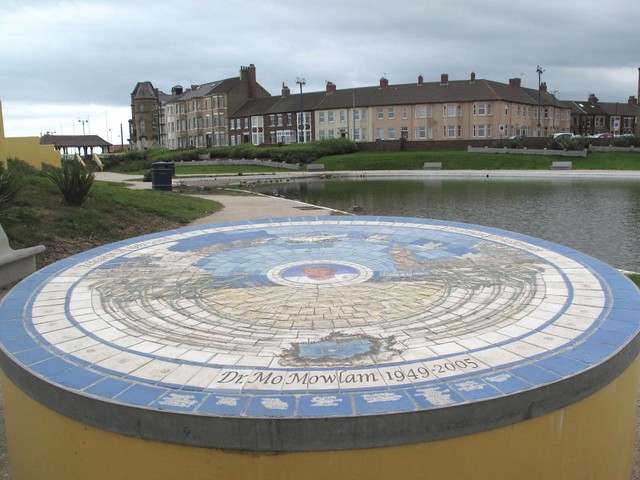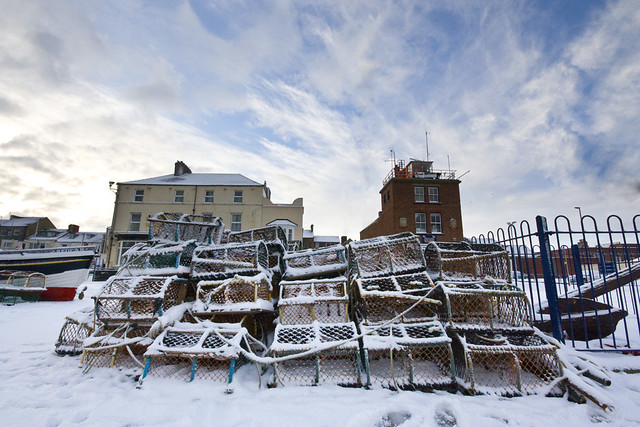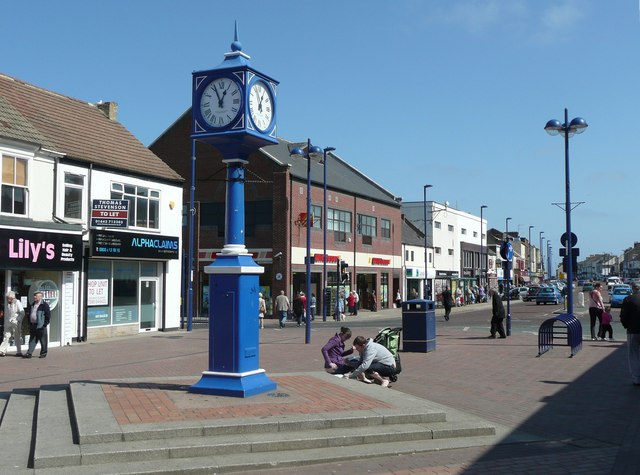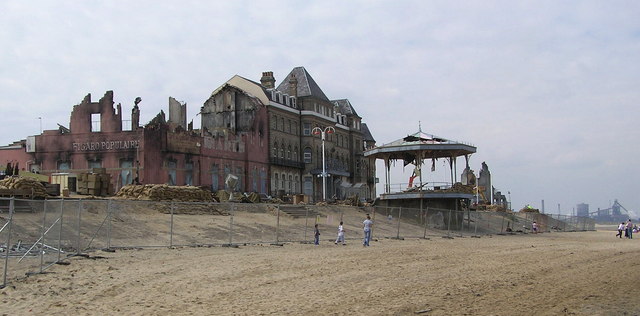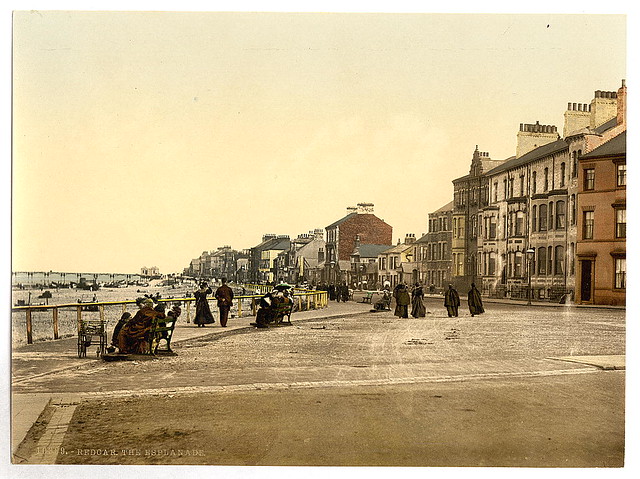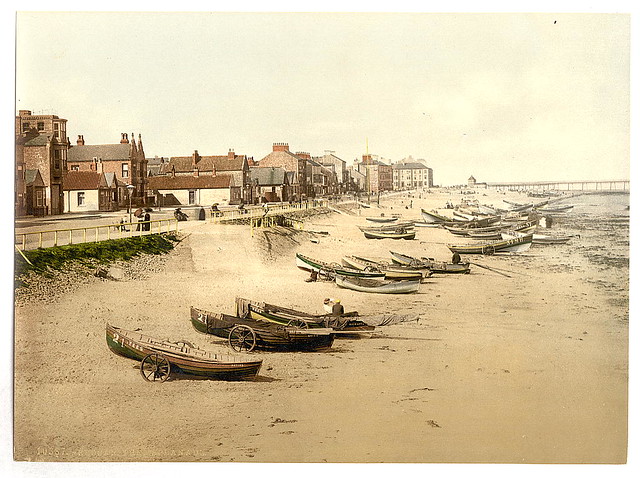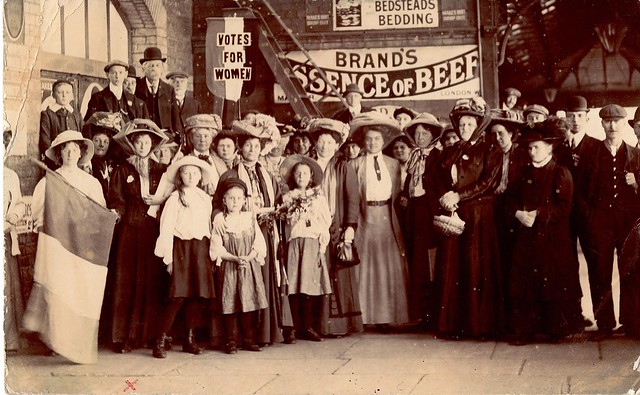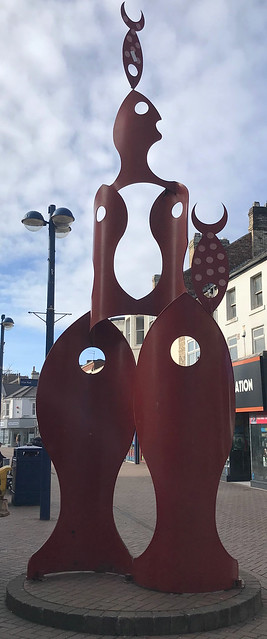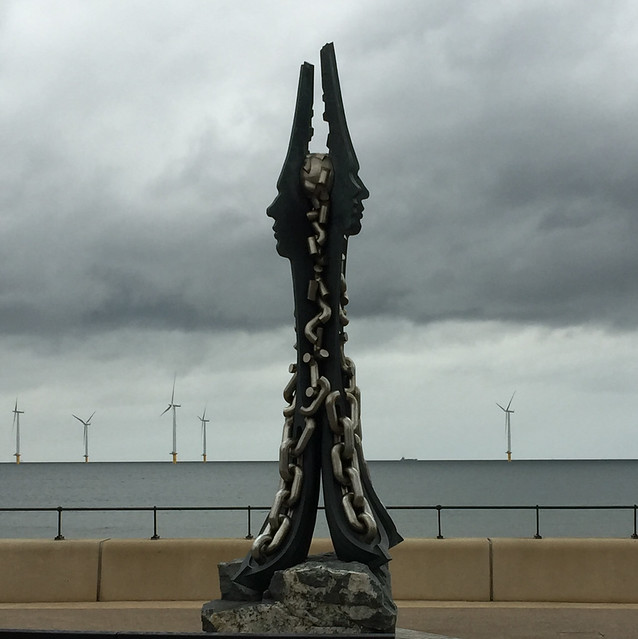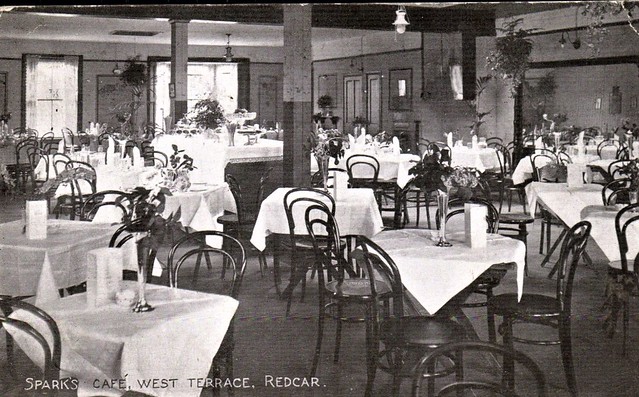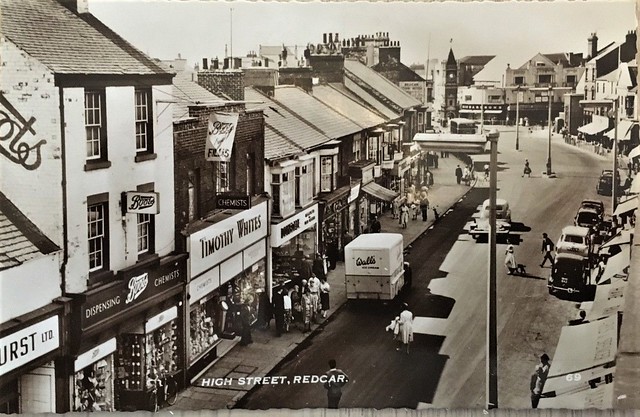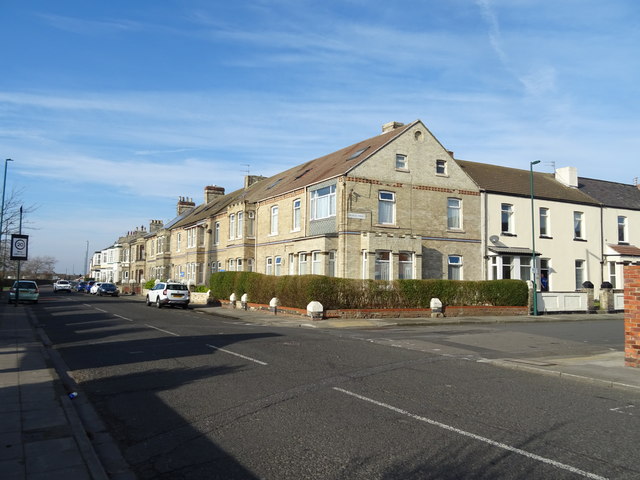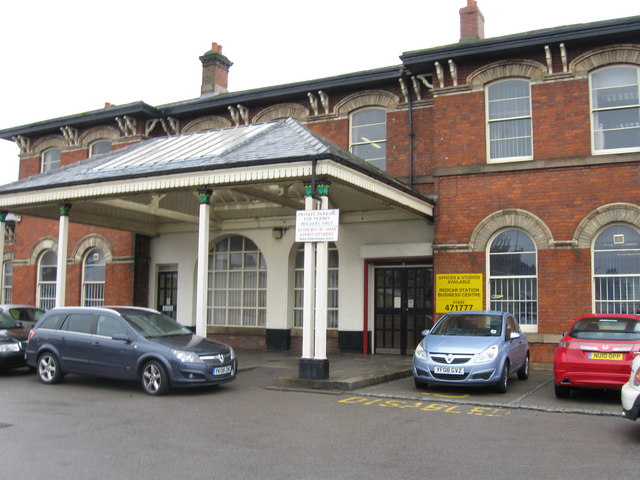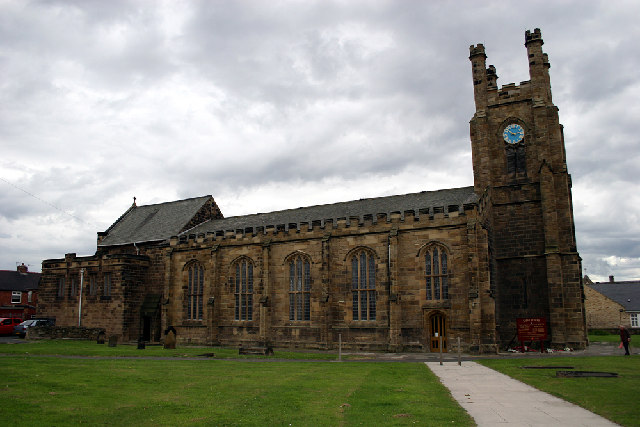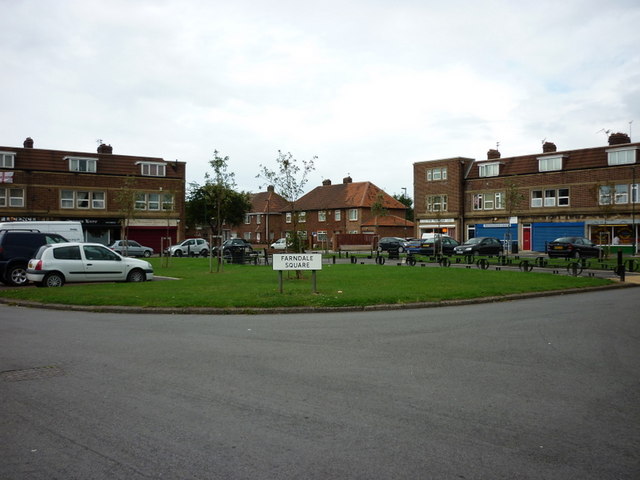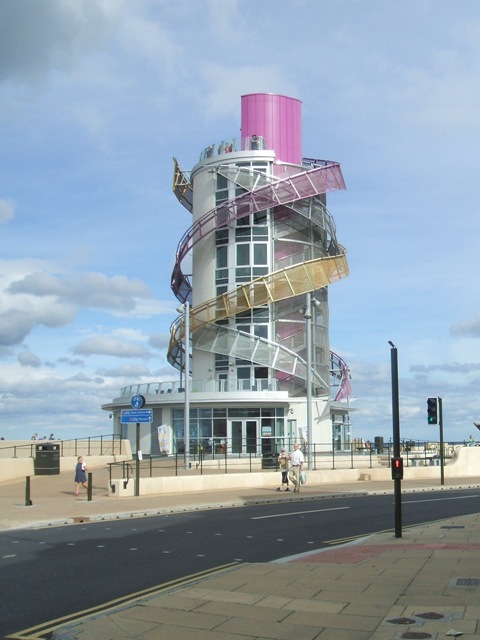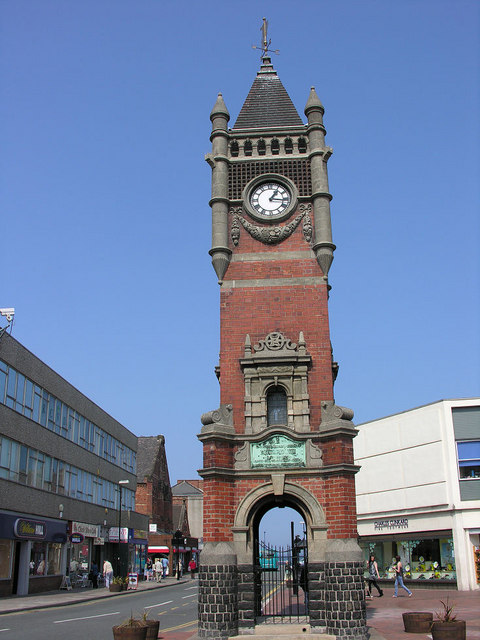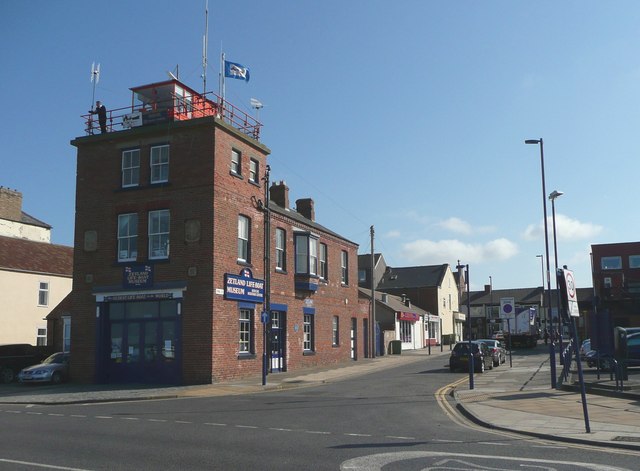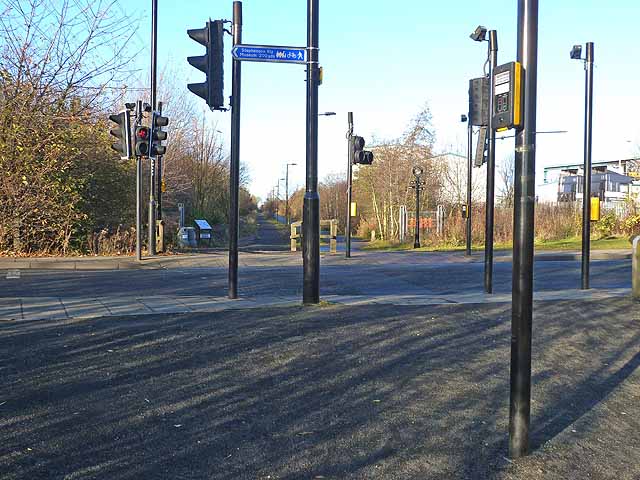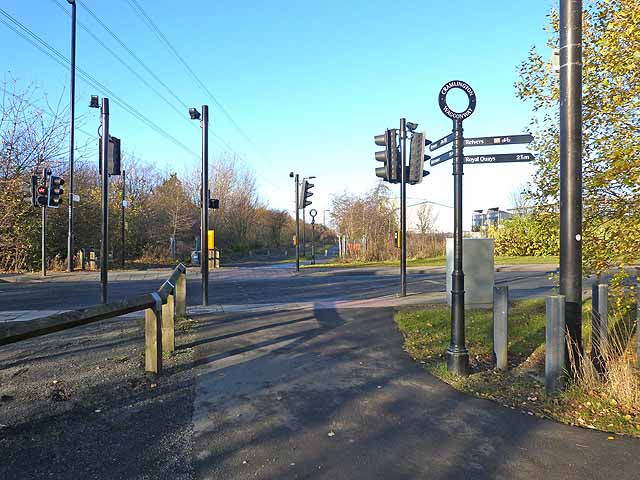Topics > Tees Valley > Redcar
Redcar
Redcar is a seaside resort and town in the Tees Valley in North Yorkshire, England. The local council, a unitary authority, is Redcar and Cleveland. Historically part of the North Riding of Yorkshire, it lies east-north-east of Middlesbrough by the North Sea coast.
The combined population of the wards of Coatham, Dormanstown, Kirkleatham, Newcomen, West Dyke and Zetland was 36,610 in the 2001 census decreasing to 35,692 in the 2011 census.
History
Redcar occupies a low-lying site by the sea; the second element of its name is from Old Scandinavian kjarr, meaning 'marsh', and the first may be either Old English rēad meaning 'red' or OE hrēod 'reed'. Redcar originated as a fishing town in the 14th century, trading with the larger adjacent market town of Coatham. Until the mid-19th century it was a sub-parish of Marske-by-the-Sea—mentioned in the Domesday book.
In 1846 work was completed on the Middlesbrough and Redcar Railway, created to attract tourism and trade, but like much of the Middlesbrough region, Redcar's real population expansion began with the discovery in 1850 of iron ore in the Eston area of the Cleveland Hills. After the construction of Redcar Racecourse in 1875, Redcar prospered as a seaside town drawing tourists attracted by its eight miles of sands stretching from South Gare to Saltburn-by-the-Sea. Numerous ships have foundered off the Redcar coastline and many of their wrecks still exist.
Redcar and Coatham piers
Plans for a pier were drawn up in 1866, but lay dormant until prompted by the announcement of plans to build a pier at Coatham in 1871. Misfortune struck both piers soon after they were built.
Coatham Pier was wrecked before it was completed when two sailing ships were driven through it in a storm. It had to be shortened because of the cost of repairs and was re-opened with an entrance with two kiosks and a roller-skating rink on the Redcar side, and a bandstand halfway along its length. In October 1898 the pier was almost wrecked when the barque Birger struck it and after was allowed to disintegrate. A glass house for concerts was added to its remaining section and in 1928 was replaced by the New Pavilion theatre which became the Regent Cinema in the early 1960s. Comedian and entertainer Larry Grayson coined his catchphrase "Shut That Door!" while performing there, as the stage door was open to the cold North Sea breeze. An anchor from the Birger can be seen on the sea front pavement opposite the Zetland Lifeboat Museum.
Disaster struck Redcar Pier in the 1880s and 1890s when a series of ships broke through it. In October 1880 the brig Luna caused £1,000 worth of damage. On New Year's Eve 1885, SS Cochrane demolished the landing stage. In 1897 the schooner Amarant went through the pier and in the following year the pier head and bandstand burnt down. In 1907 a pavilion ballroom was built on the pier behind the entrance kiosks and in 1928 it was extended. The pier was deliberately breached (sectioned) in 1940 to prevent its use by enemy invasion forces. As a result of sectioning, damage by a mine explosion and deterioration it was never reconnected and allowed to deteriorate further. The pavilion continued in use after the war but storm damage led to it being declared unsafe and it was demolished in 1980–1981.
Zetland lifeboat
The Zetland is the world's oldest surviving lifeboat. It was built by Henry Greathead of South Shields and is housed in a sea-front museum at Redcar. The museum is independent and operated by a dedicated group of volunteers. The lifeboat was first stationed at Redcar in 1802.
Governance
The town became part of the County Borough of Teesside in 1968 and was absorbed by the non-metropolitan County of Cleveland in 1974. After further changes Redcar is situated in the unitary authority of Redcar & Cleveland and in the Tees Valley region of the North East of England and also the ceremonial county of North Yorkshire.
Politically, Redcar has supported the Labour Party in parliamentary elections, allowing the town to be categorised a safe seat. From 1987 to 2001, the local MP was Mo Mowlam, from 2001 to 2010 the MP was Vera Baird. In the 2010 general election there was a swing to the Liberal Democrats with Ian Swales being elected.
Local council
The town comprises four wards: Coatham, Newcomen, West Dyke and Zetland. In addition, the suburbs of Dormanstown and Kirkleatham are two wards. On 5 May 2011 Redcar elected its councillors to Redcar & Cleveland Borough Council. There was a by-election on 18 November 2011 for two vacant seats in the Zetland ward, held onto by the Liberal Democrats, and on 19 January 2012 there was a by-election for a vacant seat in Newcomen ward subsequently gained by Labour from the Liberal Democrats.
Geography
Today Redcar is made up of numerous areas, including Coatham, Warrenby, Dormanstown, Lakes Estate, Redcar East, The Ings, Ings Farm, Mickledales and Westfield.
Economy
The town's main employers in the post-war era were the nearby Teesside Steelworks at Warrenby, founded by Dorman Long in 1917, and the ICI Wilton chemical works. The steel produced at Dorman Long was used to build the Sydney Harbour Bridge, Tyne Bridge, Auckland Harbour Bridge and many others. Both the Warrenby and Lackenby sites became part of Tata Steel when Corus was taken over in 2007, but continued to trade under the Corus name until at least February 2008. SSI bought the plant from Tata Steel in February 2011, for £320 million.
After a two-year hiatus following the mothballing of the plant in February 2010, steel was once again being made at Redcar. The Thai owners of the former Corus Plant at Lackenby, Sahaviriya Steel Industries (SSI), re-ignited the blast furnace, one of the largest in Europe, on 15 April 2012.
On 18 September 2015, production was paused due to the decline in steel prices. On 28 September 2015, the plant was "mothballed" amid poor steel trading conditions across the world and a drop in steel prices. On 2 October, the owner of the site, SSI UK, entered liquidation. On 12 October 2015 the administrator announced that there was no realistic prospect of finding a buyer and the ovens would be extinguished.
There is a small inshore fishing fleet in Redcar catching lobster, crab and fish, and offering fishing trips to tourists. As high tide at Redcar now comes up to the sea wall, fishing cobles are permitted to park up with their trailers on a broad section of sea front pavement.
Tourism, leisure and amenities
;History
After the opening of the Middlesbrough to Redcar Railway in 1846
Redcar became a regular destination for Victorian tourists.
Each year people from North Yorkshire, Leeds and Scotland visited Redcar for their holidays.
From the 19th century to the present day Redcar has featured donkey rides – owned by the Burnistons established locally in antiques and jewellery, scrap metal, mechanics and wool.
In the 1970s there were also pony rides, pony trap rides, and Roundabouts, swings, a helter skelter, and trampolining on the beach; the roundabouts and swings were run by showman Victor Vernon and his family who still have rides on the prom.
;Ice cream
Redcar's ice cream shops have included Pacitto's, Todisco's, Rea's and Kings, who also made and sold Redcar Rock.
Ice cream is sold on the promenade and a candy floss stall on the beach was also owned by the Burnistons.
The Pacitto family operate two ice cream parlours in Redcar selling their signature cone, the lemon top (dairy ice cream in a cone, with a blob of lemon sorbet on top of it).
The family previously also ran the Stray Cafe, and ice cream factory in Redcar, and an ice cream shop in Scarborough.
The owner of Todisco's was one of the numerous Italians in the area sent to Canada during the war. His ship was hit by a German torpedo, and Mr. Todisco drowned – even though he was from a country at war with the British, he was well-liked.
;The sea front
The sand beach at Redcar stretches approximately from south-east to north-west.
In the north-west the beach runs past Coatham to South Gare breakwater at the mouth of the River Tees.
To the south-east the sand beach is bordered by the Stray from Redcar's Zetland Park to Marske-by-the-Sea and then continues on to Saltburn.
The Stray is a long public open strip of coastal grassland situated between the beach and the A1085 road characterised by a series of howles (small chines) leading from the grassland to the beach.
The Redcar coastline is a major location for finding fossils of Gryphaea, also known as devil's toenails.
The main pedestrianised shopping area is based on and around High Street and runs parallel to the sea front's Esplanade.
Amusement arcades have existed at Redcar since the building of the Redcar Pier in 1873, and today the arcades are to be found along the Esplanade.
The only cinema in Redcar is the Regent on the sea front in the Coatham area of Redcar.
;Parks
The town has had several parks built for tourism: Coatham Enclosure, Locke Park, Zetland Park, Lily Park, and Amusement Park with its roller coaster.
The Amusement Park closed decades ago, and a further small sea front park known locally as Titty-Bottle Park no longer exists as such and in its place on the triangular plot of land on the Esplanade is a red and blue, brick built toilet block and tourist information centre.
Nightlife
As a seaside town, Redcar has long had a number of public houses, bars and nightclubs. On High Street is The Blue Lounge, Martha's Vineyard, the Livery, and the Plimsoll Line.
The seafront and Esplanade establishments include Aruba, the Deck, and Angels—a lap dancing club.
Sea front redevelopment
In 2010 plans for a new vertical pier and a redesign the sea front were put to the people of Redcar & Cleveland Borough.
The plans were accepted and construction started in 2011.
A group named The Redcar Pier Association formed in 2011, and campaigned for a traditional, horizontal pier.
In September 2012 the name of Redcar Beacon was chosen. Other suggested names that made it to the final were : Crow's nest, Jubilee Pier, Lemon Top Tower, Mo's Lookout, Mowlam's Beacon in Tribute to the MP for Redcar Mo Mowlam.
Redcar Skelter, Saltscar Tower, Vertical Pier.
In 2013 it was nominated for the Building Design Carbuncle Cup for worst new building.
In December 2015, the Beacon was damaged by winds from Storm Desmond, with several large pieces of panelling falling on to the beach below.
Landmarks
There are about twenty three listed buildings in Redcar. At the west end of High Street is a Grade II listed clock tower, a memorial to King Edward VII who was a regular visitor to Redcar. This tower has now been refurbished.
On the sea front stands the Victorian building of the former Coatham Hotel. The ballroom of the hotel was home to the Redcar Jazz Club, a venue for the up-and-coming bands of the late 1960s and early 1970s. Also on the sea front is the Grade II listed Zetland Lifeboat Museum.
To the east of Redcar is the listed Church of St Peter, designed by Ignatius Bonomi and built 1822–28.
In the south-east of Redcar is an aircraft listening post built in 1916 during the First World War as part of a regional defence system to detect approaching aircraft, principally Zeppelins, and give early warning. It is an example of an acoustic mirror, of which other examples can be found along the east coast of Britain. The mirror was used up until the invention of radar and although it was built on open fields today a modern housing estate now surrounds it. Only the concrete sound mirror remains and is now a Grade II listed building.
Transport
Redcar has three railway stations, on the Tees Valley Line served by Northern. From west to east, they are British Steel Redcar, with a very limited service for steel workers; Redcar Central, serving the town centre, and Redcar East about a mile to the south-east serving the residential area (unofficially) named after the station.
There has been local speculation about the development of a new station serving the expanding residential area known as the Ings, supposedly situated between Redcar East railway station and Longbeck railway station in Marske-by-the-Sea, but so far no firm plans have been agreed.
On weekdays, trains run approximately every half-hour in each direction, towards Saltburn eastbound and Middlesbrough, Darlington and Bishop Auckland westbound. There are also two of early morning through trains to Newcastle upon Tyne that run via Darlington and on to the East Coast Main Line via Durham and Chester-le-Street. Trains are less frequent in the evenings and at weekends.
The main roads through the town are the A1085 and the A1042, with the A174 bypassing.
Redcar is served primarily by Arriva North East buses, connecting Redcar with the surrounding towns and villages of Middlesbrough, Guisborough, Eston, Marske-by-the-Sea, New Marske and Saltburn-by-the-Sea.
The Pangea North and CANTAT-3 submarine telecommunication cables both come ashore between Redcar and Marske-by-the-Sea.
Education
The town's college is Redcar & Cleveland College.
The town's secondary schools are: Redcar Academy, Sacred Heart Secondary Catholic Voluntary Academy and Rye Hills School. There are eleven primary schools in Redcar: Coatham, Dormanstown, Green Gates, Ings Farm, John E Batty, Lakes, Newcomen, Riverdale, St Benedict's, Wheatlands and Zetland.
Sport
Redcar is home to Redcar Racecourse, a racecourse for thoroughbred horse racing.
There is also a motorcycle speedway racing team, the Redcar Bears racing in the Premier League.
The race track is at the South Tees Motorsport Park in Southbank Street, South Bank and is unusual in that one bend is more highly banked than the other.
The team was formerly captained by 1992 World Champion Gary Havelock and is managed by his father Brian. A junior team known as the Cubs also race in the Conference League.
Redcar Rugby Union Football club plays at Mackinlay Park.
In Coatham in the west of Redcar is Cleveland Golf Club, the first golf club to be formed in Yorkshire and one of the few links courses in the county.
Also in Coatham is Redcar Cricket Club and Redcar Running Club.
Notable people
The American novelist Nathaniel Hawthorne came to Redcar on 26 July 1859 in search of peace and quiet while he worked on the manuscript of The Marble Faun. Hawthorne's house, formerly known as the Hawthorne Cafe, stands at the junction of High Street and King Street.
Gertrude Bell, colonial administrator and colleague of Lawrence of Arabia spent her youthful years at Red Barns House in Coatham, now the Red Barns Hotel and a listed building, and which is being considered as a museum to Bell.
The surviving negatives of Redcar photographer Alfred Edward Graham (1882–1945) were acquired by Redcar Urban District Council's Library and Museum Committee and are now held by the Redcar and Cleveland Museum Service.
Rex Hunt, governor of the Falkland Islands during the 1982 invasion by Argentina, attended Coatham School.
The late Minister for Northern Ireland, Mo Mowlam, represented Redcar in the House of Commons.
Film and television actors and actresses Pip Donaghy, June Laverick, and Wendy Hall, and actor/director/producer Robert Porter were all born in Redcar. Actor and radio actor Felicity Finch, famous for her part in the Archers BBC Radio 4 drama series, playing Ruth Archer, was also born and grew up in Redcar.
Singer David Coverdale, lead singer with Deep Purple and Whitesnake lived in Redcar as a youth and worked in the Gentry clothes shop on Coatham Road.
Chris Norman, founder member and former lead singer of Smokie was born in Redcar.
Pete York, drummer with the Spencer Davis Group and session drummer was born in Redcar.
Paralympian, Baroness Tanni Grey-Thompson, originally from Wales, lived in Redcar for a number of years with her husband and daughter.
2011 and 2016 UCI Downhill World Champion Danny Hart was born in and currently lives in Redcar, he is frequently nicknamed "The Redcar Rocket" by commentators.
Robbie Stockdale, ex Middlesbrough footballer and now first team coach of Premier League side Sunderland was born in Redcar.
David Wheater, Bolton Wanderers and England national football team central defender, grew up and still lives in Redcar.
Snooker player Mike Dunn was born in Middlesbrough but lives in Redcar.
The careers of Oscar-Tony's-BAFTAs grand slam awards winner Mark Rylance, along with Gary Oldman and many other high-profile stage and screen actors took off from the streets of Redcar, on stage at the Glasgow Citizens' Theatre in 1981, as well as at London's RADA, through 'Desperado Corner' a play written and set in 1959 Redcar by playwright and former Redcar resident Shaun Lawton. Lawton lived in Redcar from 57-63, attended Cleveland Tech from its opening, got football lessons from Brian Clough and Peter Taylor! From 57 to 59 he was a chippie at Reas. He has lived in Berlin since 1978 as a poet and singer songwriter as well as a screen actor and voice artist.
Cultural references
Atonement (film)
In 2006, Redcar was used as a location for the film adaptation of the Ian McEwan novel Atonement. The Coatham Hotel, Regent Cinema, a section of Newcomen Terrace and part of the beach were dressed as 1940s Dunkirk. Filming took place across three days in August 2006, with local men playing the soldiers.
The Secret Millionaire (TV programme)
In 2010, Redcar was featured on the Channel 4 programme, The Secret Millionaire.
David Jamilly a humanitarian, philanthropist and self made millionaire, visited the Redcar community and gave £25,000 to Zoë's Place for a sensory room, £25,000 to Redcar Amateur Boxing club to start an Olympic fund and £25,000 to Sid's place for special counselling.
There was a subsequent visit on 14 May to a screening at Redcar's cinema, attended by the mayor and mayoress along with all the charities and people involved.
The feature of the documentary involved the closure of the nearby Corus steelworks as well as the charities.
On 9 December 2011 David Jamilly officially opened the new Redcar Education Development (R.E.D.) centre in Park Avenue, Redcar. R.E.D. provide day care for adults with learning difficulties.
David Jamilly also officially opened the Redcar Primary Care Hospital on 9 December 2011 and the new Sid's Place on 15 December 2011.
The Last of the Flying Finns (Novel)
Redcar is used as the main location in the novel The Last of the Flying Finns.

from Newcastle University (youtube)
"For Those In Peril On The Sea ..." (1931)
Pinned by Simon Cotterill
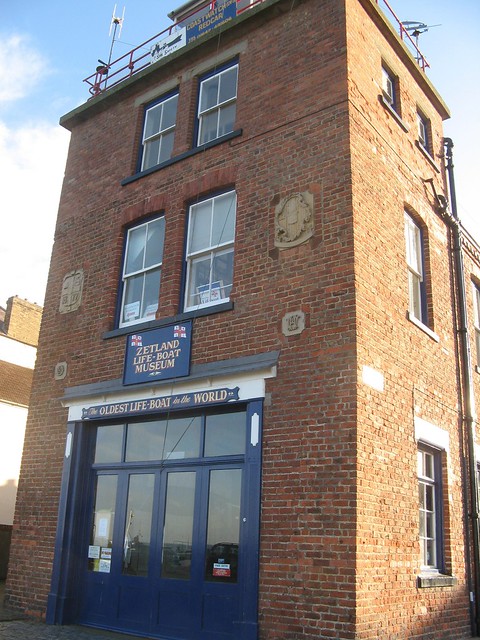
from Flickr (flickr)
Zetland Lifeboat Museum Redcar Tees Valley Coast North East
Pinned by Simon Cotterill
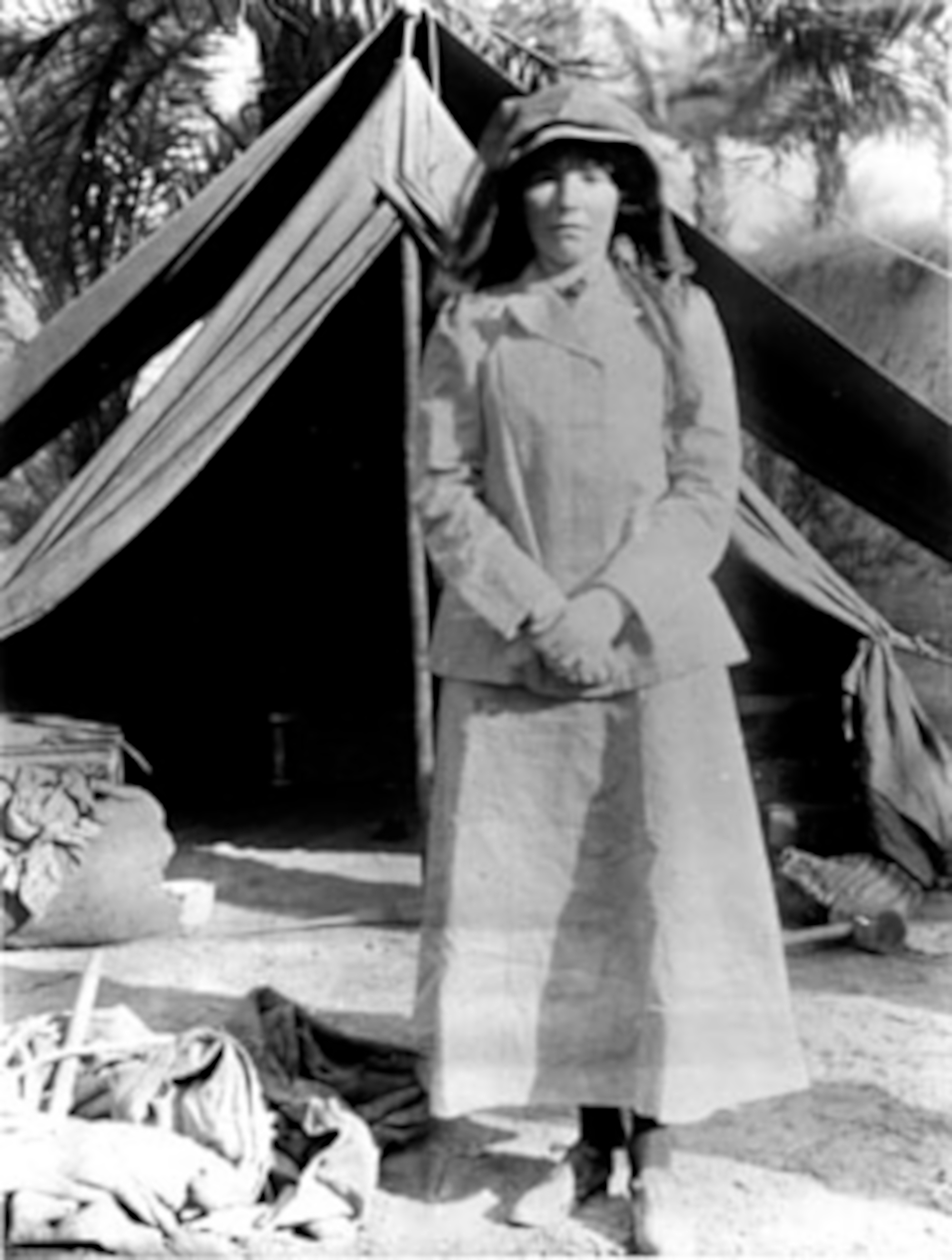
Co-Curate Page
Gertrude Bell (1868-1926)
- Links with the NE Life and Times Gertrude Bell was an archaeologist, a linguist, traveller, and the greatest woman mountaineer of her age. She played a major role in establishing …

from Youtube (youtube)
DJI Phantom 3 Standard Drone at South Gare Redcar 17/07/2017
Pinned by Simon Cotterill

Co-Curate Page
Sir Hugh Bell (1844 - 1931)
- Overview About Sir Hugh Bell Sir (Thomas) Hugh Bell (1844 - 1931) was a director of his family's steelworks business at Middlesbrough; Bell Brothers. He was also a director of …


from Newcastle University (youtube)
"For Those In Peril On The Sea ..." (1931)
Pinned by Simon Cotterill

from Flickr (flickr)
Zetland Lifeboat Museum Redcar Tees Valley Coast North East
Pinned by Simon Cotterill

Co-Curate Page
Gertrude Bell (1868-1926)
- Links with the NE Life and Times Gertrude Bell was an archaeologist, a linguist, traveller, and the greatest woman mountaineer of her age. She played a major role in establishing …

from Youtube (youtube)
DJI Phantom 3 Standard Drone at South Gare Redcar 17/07/2017
Pinned by Simon Cotterill


